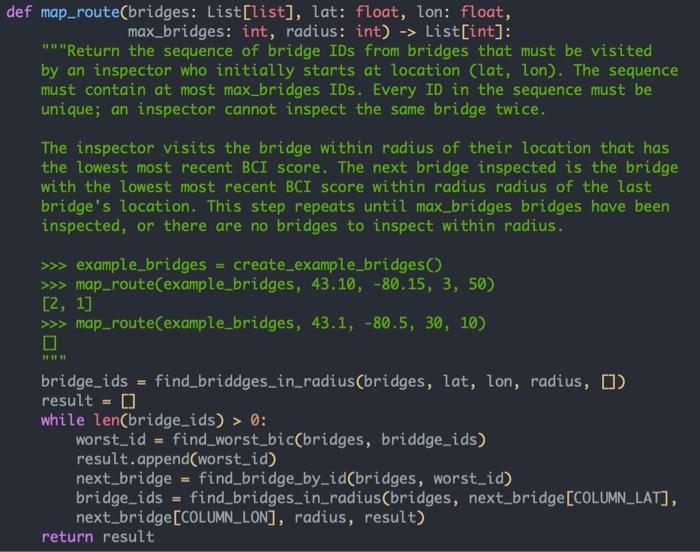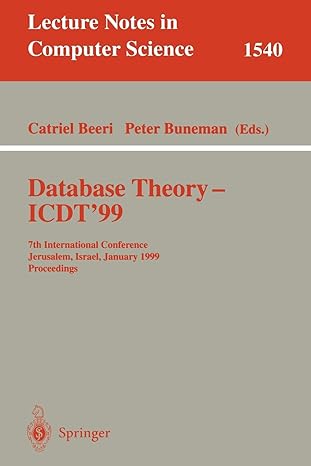Answered step by step
Verified Expert Solution
Question
1 Approved Answer
please help me to write the body of the functions below!! please use the function find_bridges_in_radius to write the body of map_route from typing import
please help me to write the body of the functions below!! please use the function find_bridges_in_radius to write the body of map_route
from typing import List
import csv
import math
################################################################################
# Begin constants
################################################################################
COLUMN_ID = 0
COLUMN_NAME = 1
COLUMN_HIGHWAY = 2
COLUMN_LAT = 3
COLUMN_LON = 4
COLUMN_YEAR_BUILT = 5
COLUMN_LAST_MAJOR_REHAB = 6
COLUMN_LAST_MINOR_REHAB = 7
COLUMN_NUM_SPANS = 8
COLUMN_SPAN_DETAILS = 9
COLUMN_DECK_LENGTH = 10
COLUMN_LAST_INSPECTED = 11
COLUMN_BCI = 12
INDEX_BCI_YEARS = 0
INDEX_BCI_SCORES = 1
MISSING_BCI = -1.0
EARTH_RADIUS = 6371
################################################################################
# Sample data for docstring examples
################################################################################
def create_example_bridge_1() -> list:
"""Return a bridge in our list-format to use for doctest examples.
This bridge is the same as the bridge from row 3 of the dataset.
"""
return [
1, 'Highway 24 Underpass at Highway 403',
'403', 43.167233, -80.275567, '1965', '2014', '2009', 4,
[12.0, 19.0, 21.0, 12.0], 65.0, '04/13/2012',
[['2013', '2012', '2011', '2010', '2009', '2008', '2007',
'2006', '2005', '2004', '2003', '2002', '2001', '2000'],
[MISSING_BCI, 72.3, MISSING_BCI, 69.5, MISSING_BCI, 70.0, MISSING_BCI,
70.3, MISSING_BCI, 70.5, MISSING_BCI, 70.7, 72.9, MISSING_BCI]]
]
def create_example_bridge_2() -> list:
"""Return a bridge in our list-format to use for doctest examples.
This bridge is the same as the bridge from row 4 of the dataset.
"""
return [
2, 'WEST STREET UNDERPASS',
'403', 43.164531, -80.251582, '1963', '2014', '2007', 4,
[12.2, 18.0, 18.0, 12.2], 61.0, '04/13/2012',
[['2013', '2012', '2011', '2010', '2009', '2008', '2007',
'2006', '2005', '2004', '2003', '2002', '2001', '2000'],
[MISSING_BCI, 71.5, MISSING_BCI, 68.1, MISSING_BCI, 69.0, MISSING_BCI,
69.4, MISSING_BCI, 69.4, MISSING_BCI, 70.3, 73.3, MISSING_BCI]]
]
def create_example_bridge_3() -> list:
"""Return a bridge in our list-format to use for doctest examples.
This bridge is the same as the bridge from row 33 of the dataset.
"""
return [
3, 'STOKES RIVER BRIDGE', '6',
45.036739, -81.33579, '1958', '2013', '', 1,
[16.0], 18.4, '08/28/2013',
[['2013', '2012', '2011', '2010', '2009', '2008', '2007',
'2006', '2005', '2004', '2003', '2002', '2001', '2000'],
[85.1, MISSING_BCI, 67.8, MISSING_BCI, 67.4, MISSING_BCI, 69.2,
70.0, 70.5, MISSING_BCI, 75.1, MISSING_BCI, 90.1, MISSING_BCI]]
]
def create_example_bridges() -> List[list]:
"""Return a list containing three unique example bridges.
The bridges contained in the list are from row 3, 4, and 33 of the dataset
(in that order).
"""
return [
create_example_bridge_1(),
create_example_bridge_2(),
create_example_bridge_3()
]
################################################################################
# Helper function
################################################################################
def calculate_distance(lat1: float, lon1: float,
lat2: float, lon2: float) -> float:
"""Return the distance in kilometers between the two locations defined by
(lat1, lon1) and (lat2, lon2), rounded to the nearest meter.
>>> calculate_distance(43.659777, -79.397383, 43.657129, -79.399439)
0.338
>>> calculate_distance(43.42, -79.24, 53.32, -113.30)
2713.226
"""
# This function uses the haversine function to find the
# distance between two locations. You do NOT need to understand why it
# works. You will just need to call on the function and work with what it
# returns.
# Based on code at goo.gl/JrPG4j
# convert decimal degrees to radians
lon1, lat1, lon2, lat2 = (math.radians(lon1), math.radians(lat1),
math.radians(lon2), math.radians(lat2))
# haversine formula t
lon_diff = lon2 - lon1
lat_diff = lat2 - lat1
a = (math.sin(lat_diff / 2) ** 2
+ math.cos(lat1) * math.cos(lat2) * math.sin(lon_diff / 2) ** 2)
c = 2 * math.asin(math.sqrt(a))
return round(c * EARTH_RADIUS, 3)


Step by Step Solution
There are 3 Steps involved in it
Step: 1

Get Instant Access to Expert-Tailored Solutions
See step-by-step solutions with expert insights and AI powered tools for academic success
Step: 2

Step: 3

Ace Your Homework with AI
Get the answers you need in no time with our AI-driven, step-by-step assistance
Get Started


